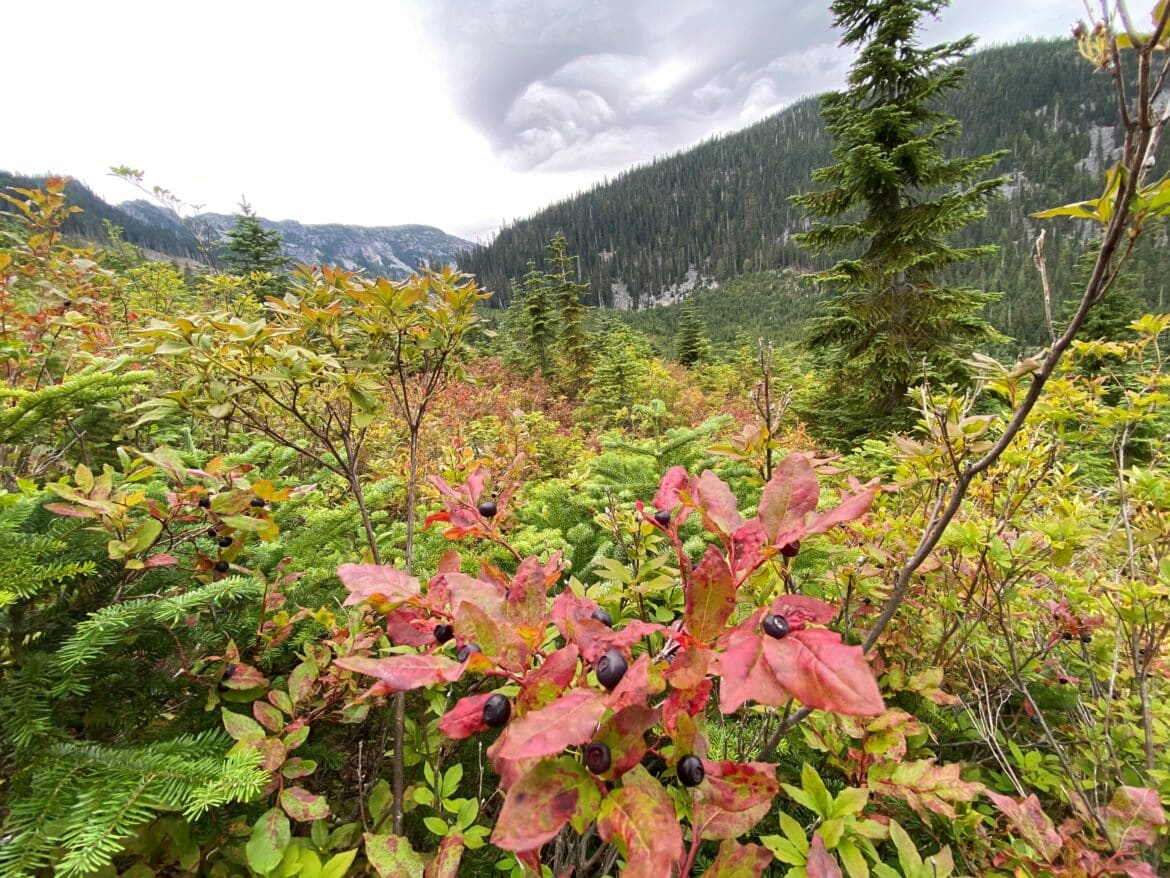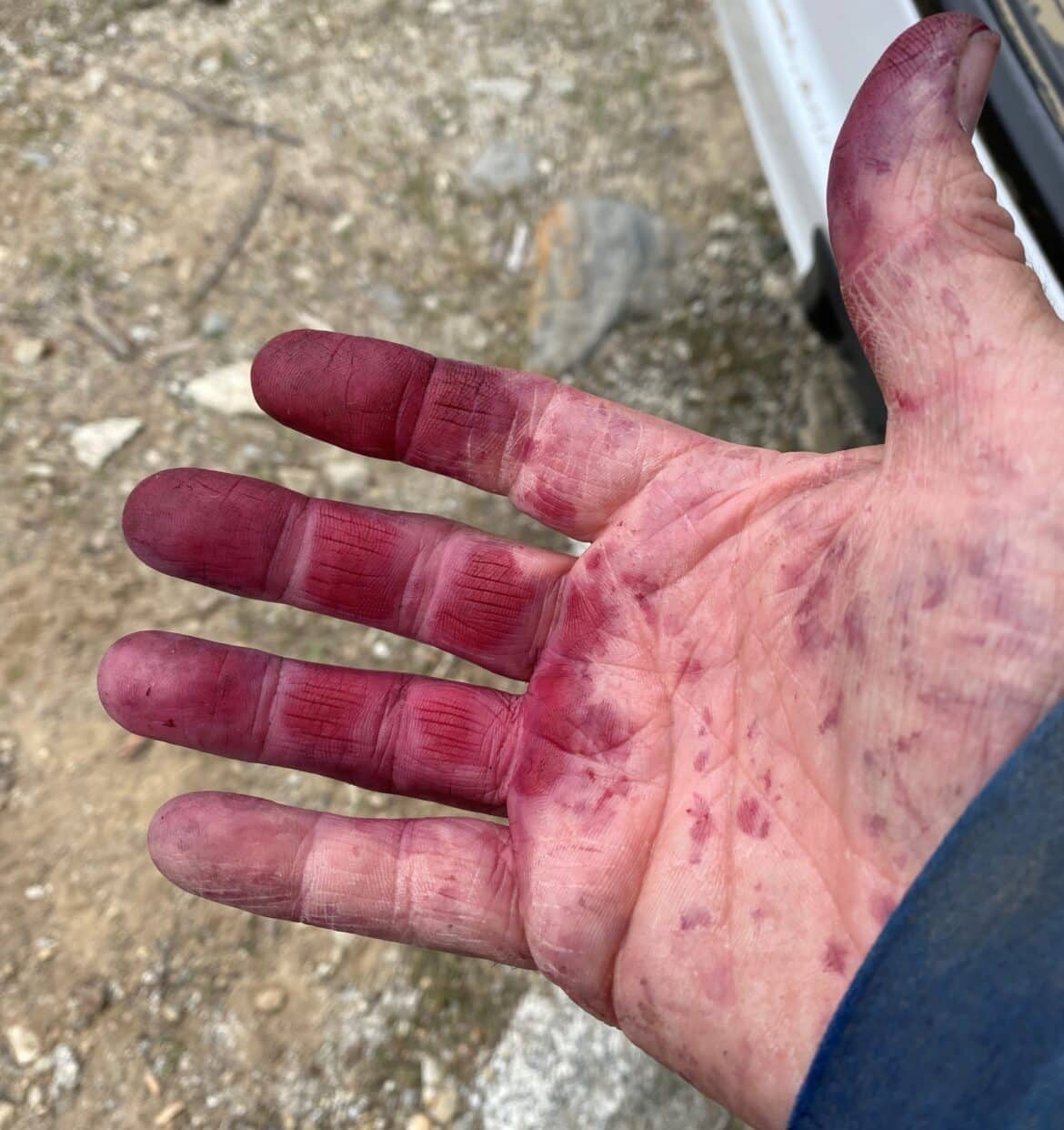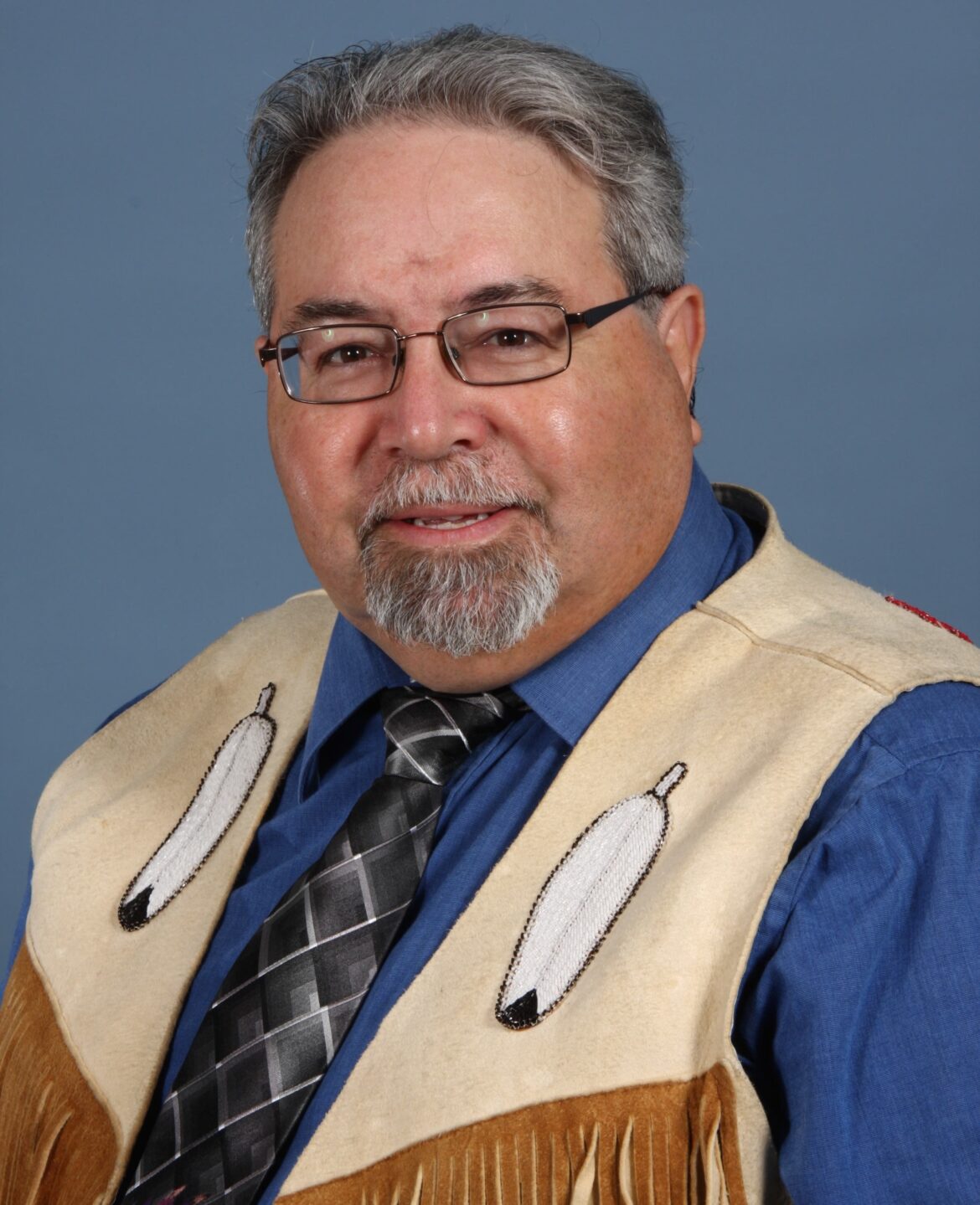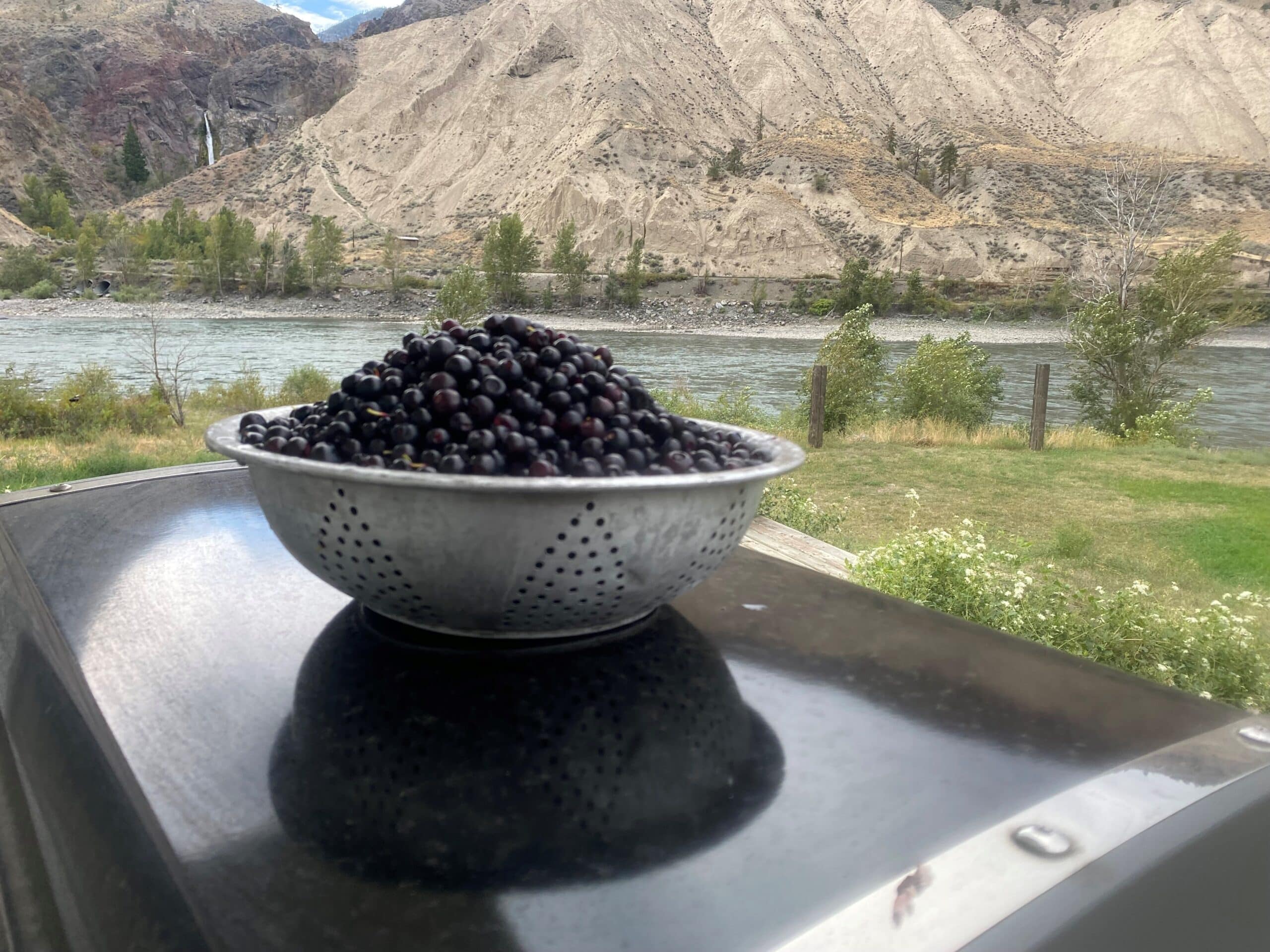By Lisa Houle | September 18, 2024
“Being able to address invasive species proactively before they become a problem is critical – not just for our Indigenous culture and way of life, but for life on the planet as a whole.” – Dave Walkem
Black huckleberry (vaccinium membranaceum), a small berry rich in antioxidants, is known to boost immunity and healing. It grows in mid to high elevations in dry to moist coniferous forests and in openings in the montane forests. It is common throughout B.C., except in Haida Gwaii. Related to blueberries and cranberries, the black huckleberry is prized as a super fruit for its healthful properties.
Huckleberry has been a food staple for Indigenous peoples for generations. Harvesting this versatile fruit is important to communities for both food security and continuing traditional practices. Fresh huckleberries are eaten while in season, with the majority canned, frozen, jammed or dried for the winter months. Good huckleberry picking areas were traditionally managed by fire to keep the opening clear of trees.
Protecting huckleberries from the threat of invasive species is important to preserving important traditional practices.

Dave Walkem is the Senior Manager of Strategic Partnerships at the Invasive Species Council of B.C. He is Nlakaʼpamux – also known as ‘Thompson Indian Interior Salish Group’ and a member of the Cook’s Ferry Indian Band. Fishing for sockeye salmon and harvesting huckleberries was a significant part of their traditional economy and food source.
“We were quite nomadic depending upon the season. We primarily followed the salmon along the Thompson and Fraser Rivers – that was our main economy. But for hunting and gathering we went into the surrounding mountains and down into the upper Skagit, which is part of the U.S.,” said Dave, recalling how plentiful the salmon were in the mid-70’s. “I’m 69 years old. When I was a child, every year the Thompson River would have a ribbon of red along each shoreline through September into October with the returning sockeye salmon. We fished from June and primarily dried our salmon in August and September. The salmon did have a massive return in 2010 – you could see them then, but not anywhere near what I recall as a child.”
Berry harvesting was also much different in years past.
“In order to get to our hunting and huckleberry picking areas, you would go by horseback – when we were a little bit older, we would go by vehicle, on very small 4×4 roads. There was lots of game, lots of plants, and you didn’t have to go that far. Since the 1970’s, logging practices opened the roads and the areas for other hunters and we had to go further to gather our food,” said Dave.
Dave’s territory has endured intense wildfires and flooding in the last few years. A small section of the northeast part of the territory has remained untouched by fire, but most of that area had previously endured the mountain pine beetle outbreak.
“I live in Spences Bridge so in 2017 the Elephant Hill Fire started just north of our reserves and devastated the northern part of our territory. In 2020 we had the atmospheric river that impacted a large part of our access to many parts of our territory. In 2021 we had the Lytton fire come up from the south and east, which burned right beside Spences Bridge on both sides of the river. This year we had the Shetland Creek fire, which burned the western part that the (previous) Lytton Fire didn’t get,” said Dave.

The huckleberry harvest was variable this year, likely due to unseasonably warm temperatures in December of 2023. As fires and flooding had destroyed the access areas to the berry patches, Dave had to find an alternate route. That’s when he noticed a change in the landscape.
“As soon as we got past the burned area, there were a number of invasive species alongside the road that I had never seen up there before. It was a real eye opener,” said Dave, noting that as more people arrive from outside an area, the higher the chance that invasive plants such as knapweeds, hawkweeds, sulfur cinquefoil and blueweed (to name a few) begin to appear. “In order to get to these areas, we’re going through areas that are infested with invasive species and we’re probably spreading some invasives ourselves, which is disturbing. Invasive species are all along the road systems because that’s where people travel.”
Knowing what impact invasive species will have on harvesting practices remains to be seen.
“We’re still able to access our areas by ATVs or 4×4’s. But invasive species are a bit of a sleeper agent at this point. We’re helping advance the invasives into these more sensitive areas and that may have a bigger impact on our food supplies going forward,” said Dave.
When he thinks about the forests, the grasslands and the waters on his territory, Dave’s concern is with the natural balance for his community.
“The relationships between plants and animals and ourselves has been a time-honoured balance that has sustained us. The focus of our Indigenous teachings is the respectful relationship with the environment around us. Invasives are coming in and replacing a lot of these plants and animals and we don’t know what that does to the balance and our ability to sustain ourselves off the land. Some of the invasives like thistles or tumbleweeds make it difficult to gather some foods as you essentially walk through armored plants – and it discourages us,” said Dave, noting that traditional practices need to be upheld, and knowledge passed on to future generations. “It’s that balance that that we are part of – a healthy ecosystem, a healthy water system and a healthy people – because it’s part of our nutrition. You are what you eat, if you will.”
Dave is hopeful that more people will learn about and adopt Indigenous values. “What has been lost in the Western science approach is that we, as a society, think we can manage nature – clean water and clean air, and all of these complex systems – for our benefit. We are part of a system, not in charge of this system,” said Dave. “Over the last few years, the Association of B.C. Forest Professionals has taken on Indigenous values in terms of realizing that to have a healthy forest, you need to look after the land and all its components, not just plant a row of fast-growing trees.”
Looking after the land includes managing invasive species to maintain nature’s balance.
“I think understanding how invasive species get here and their potential impact is critical for us. If you throw an invasive species in it upsets that balance – then we’ve got some serious problems to deal with us as society and our way of life,” said Dave. “Being able to address invasive species proactively before they become a problem is critical – not just for our Indigenous culture and way of life, but for life on the planet as a whole.”

Dave Walkem has accomplished many things over his career. He has served as Chief and Councillor of the Cooks Ferry Indian Band, he is a Registered Professional Forester (now retired), and was the first registered Status Indian in BC to receive that designation. Dave has contributed to many grassroots initiatives and he sits on a number of Boards. He works as ISCBC’s Senior Manager of Strategic Partnerships. He lives in Spences Bridge, and is a proud Father, Grandfather and Great-Grandfather.
Learn more about ISCBC’s Indigenous Connections.
Lisa is a Communications and Outreach Coordinator at ISCBC. She values a diverse environment and connecting with others about environmental protection. In her spare time Lisa enjoys spending time at the ocean and beach combing for sea glass. You can reach Lisa at lhoule@bcinvasives.ca
Share


















